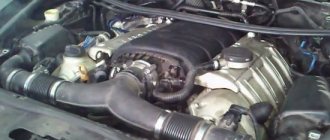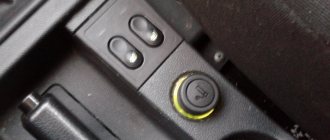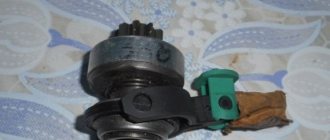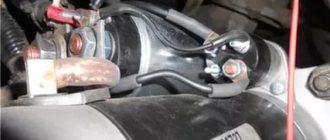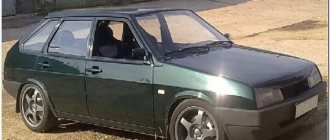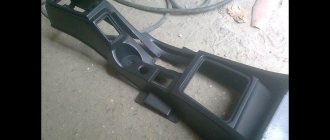general information
The starter is the key mechanism that ensures the starting of any vehicle equipped with an internal combustion engine. In fact, it is an electric motor equipped with a special gear with a transmission mechanism. When activated, the part engages with the flywheel and rotates it, thereby providing a start to the gasoline engine.
The control element is a solenoid relay. It supplies voltage to the unit’s motor and regulates the stroke of the bendix. When the driver turns the key in the ignition, an electrical circuit is activated. Current flows to the relay magnet, which attracts the armature, which closes the contact group, which causes the starter to spin.
The force it creates is transferred to the flywheel, the crankshaft begins to rotate and the car engine starts. After this, the driver releases the key, the power is turned off, and the relay opens the contacts, after which the starter stops working.
Where are the fuses on the Priora?
- The main mounting block of the Priora is closed with a lid and located at the driver’s left foot. To open it, you need to turn three latches 90° and unclip the lid.
- The fuse box is under the hood, which is located near the expansion tank.
- Another mounting block, which is located near the left foot of the front passenger. To gain access to the fuses and relays, unscrew several screws with a Phillips screwdriver.
This is interesting: Wiring diagram for the power window button
Below is a description of each fuse and relay block in order.
If Priora does not want to start
When the car does not start and its starter, accordingly, does not turn, then most likely the culprit is the battery. This is indicated by the following additional symptoms:
- the solenoid relay clicks;
- The instrument lights on the panel go out.
The easiest way to test the battery is to turn on the headlights. If they burn weakly, you will have to charge the battery.
When the battery appears to be in good condition, but the car still does not start, feel the cables connected to it. If the ends screwed to the terminals (or the starter itself) are warm, then there is poor contact or oxidation. All this creates increased resistance, stealing battery power.
Here:
- unscrew the wires;
- clean the battery leads and terminals themselves;
- return the cables to their place;
- Make sure that the ground on the body and the positive on the starter are securely fastened.
Next, check if there is voltage at the ignition switch. This is done like this:
- disconnect the connector of the cable going from it to the traction relay;
- turn the key to the engine start position;
- measure the voltage at the connector.
Fuses and relays in Lada Priora, electrical diagrams
Lada Priora is another car in the line of new VAZ cars, which is gaining popularity among segments of the population. External similarities with the 10th model attract the attention of young people; the relatively low price is also a reason for purchase for most car enthusiasts. Along with the growth in popularity, the owners of this model are gaining experience in repair and maintenance, which is becoming more and more every year.
If your Priora has electrical problems, do not rush to get upset; first, check the fuses and relays in your Lada Priora. These are the ones that will be discussed in this article.
Block in the cabin
The fuse box in Priora is located at the bottom of the dashboard, on the left side of the steering wheel. To get to it, you need to open the cover, which is held on by three latches. Rotate each locking knob 90 degrees and pull the lid down and it will snap open.
Fuses in the interior mounting block
F1 (25 A) - radiator cooling fan . If your fan does not work, check its motor by applying 12 V directly to it from the battery. If the engine is working properly, then most likely the problem is in the wiring or connectors. Check the serviceability of relay K1.
If the fan runs constantly and does not turn off, check the coolant temperature sensor located on the thermostat. If you remove the connector from the working sensor, the fan should turn on. Check the wiring to this temperature sensor, as well as the contacts of relay K1, move this relay, clean the contacts. If this is the case, replace it with a new relay.
F3 (10 A) - high beam, right headlight . F4 (10 A) - high beam, left headlight . If the headlights do not shine on high beam, check the K7 relay and the headlight bulbs. The steering column switch, wiring or connectors may also be faulty.
F5 (10 A) - sound signal.
If the signal does not work when you press the steering wheel button, check relay K8. The signal itself is located under the radiator grille; you can get to it by removing the plastic casing from above. Check it by connecting the voltage to 12 V. If it doesn’t work, try turning the adjusting screw, or replace it with a new one.
F6 (7.5 A) - low beam, left headlight . F7 (7.5 A) - low beam, right headlight . When replacing lamps, be careful; there are separate lamps for the low and high beams, so they can be easily confused. It is better not to install lamps in high-power headlights; the reflectors may melt and the desired effect will not be achieved. Most low beam headlight problems that cannot be corrected by conventional means can be related to the light control module (LCM). The low beam relay is only available in cars equipped with a light sensor, it is located in the place of relay K1; on most cars this relay is not in the mounting block; the low beam circuit goes through the MUS block. It happens that the tracks in the block burn out; if there are problems, it is better to replace it with a new one. If the windshield wipers turn on spontaneously when the low beam is not working correctly, the problem is most likely in the windshield wiper control unit, located in the center of the dashboard, the topmost block, next to the radio, is best reached from the glove compartment, or by hand through the removed console covers at the feet.
F8 (10 A) - alarm signal . If the alarm does not work, also check relay K9.
F9 (25 A) - stove fan.
If your stove does not work in any mode, the problem may be with the stove speed controller or with the engine. Check the stove motor by applying 12 V voltage directly to it. If it does not work, remove it, open the cover and check the condition of the brushes. If the stove does not work only in the first modes, but works in the last mode, most likely you need to replace the heater resistance, located under the hood on the fan scroll.
The price of these resistors is about 200 rubles. Also check that the filter and all pipes are clean and that air flows normally into the stove. If the stove fan squeaks or turns with difficulty, try lubricating it. If the stove turns on and off, check the connectors and contacts in them, they could have melted or oxidized, in this case, replace the connector.
If the car has an air conditioner, the thermal fuse may burn out; it is located near the additional resistance; the fan fuse in the configuration with the air conditioner is located under the hood in the power fuse box.
F10 (7.5 A) - instrument panel, interior lights, brake lights.
If your instrument needles and gauges on the panel stop working, most likely the problem is in the connector that fits it. Check to see if it has fallen out and inspect its contacts. It may also be due to burnout of the tracks on the panel board. In this case, you need to disassemble the panel and inspect it. It can be easily disassembled by unscrewing the screws on top under the trim, on the bottom near the fuse cover and on the side.
If your brake lights do not work, none of them including the additional interior light, most likely the problem is in the switch, which is located at the base of the brake pedal, check and replace it. If some of the brake lights work and some don't, the bulbs are most likely burnt out. To replace the lamp you need to remove the headlight. To prevent the lamps from burning out, replace them with better ones.
F11 (20 A) - heated rear window, windshield wipers . If the heating does not work, see information about F2. If the front wipers do not work, check the tightness of the nuts on the shafts and the operation of the gear motor by removing it and applying 12 V voltage to it. If the motor is faulty, replace it with a new one. Removing the motor is problematic due to the design, so it is better to contact a car service.
The price of a new engine is about 1,800 rubles (if the car is not under warranty). Also check the steering column switch, it may be faulty or its contacts have oxidized.
This is interesting: A tool for pulling out dents on a car
F12 (10 A) - pin 15 from the devices.
F13 (15 A) - cigarette lighter . If your cigarette lighter does not work, check its contacts and wiring. Typically, problems with the cigarette lighter occur due to a short circuit after using non-standard or low-quality connectors. To replace the cigarette lighter, you need to remove the center console.
F14 (5 A) - left-hand side lamps . F15 (5 A) - right-side lamps . If your headlights stop working and the dashboard backlight does not light up, most likely the problem is in the light control module (LCM), check all the connectors and contacts in them; if the module is faulty, replace it with a new one. If the dashboard lights work, but the dimensions do not, most likely the problem is in the wiring or contacts. Don't forget to check the lamps themselves.
F16 (10 A) - Pin 15 from ABS.
F17 (10 A) - left fog lamp . F18 (10 A) - right fog lamp . If the PTF stops working, the lamps may have burned out, check if there is voltage in their connectors. If there is no voltage there, then in addition to the fuses, there is either wiring, or connectors, or a relay. Also check the power button in the cabin. The lamps in the “foglights” can be replaced by unscrewing the bumper or one side of it, or by unscrewing the fender liners and turning the wheels towards the headlight being replaced, or you need to unscrew the protection from below. You cannot install xenon in the PTF, because there is no tilt angle corrector and there is a high probability of blinding oncoming drivers.
F19 (15 A) - heated seats . If the heated front seats stop working, check the connector under the seat, wiring and the power button.
F20 (5 A) - immobilizer.
The immobilizer blocks the ignition circuit and the operation of the fuel pump. If the immobilizer does not see or loses the key, and also does not work correctly, try replacing the battery in the key. The electrical package control unit, which is located in the center of the dashboard, in the area of the radio, the second unit from the top with a black housing, could have failed. If you have lost your key and want to use a new one, you will need to register it in the immobilizer firmware.
If you disable the immobilizer, a light with a key symbol will light up on the panel, this means that it is looking for a key.
F21 (7.5 A) - rear fog lamp.
F22-30 - backup fuses.
F31 (30 A) - electrical package control unit .
Lada won't start when cold
Check how fast the crankshaft spins on your Priora. Too low a speed indicates:
- dead battery;
- hardening of the lubricant.
The absence of any reaction from the motor suggests that the problem lies in:
- fuel system - sometimes condensate freezes there;
- a sensor that monitors the temperature of the antifreeze;
- loss of tightness of nozzles;
- weak compression in the cylinders;
- failure in the on-board computer.
If the car starts unstably in winter, then perhaps there is low-quality gasoline in the Priora tank or a lot of condensate has accumulated. It would also be a good idea to look at the spark plugs and the cables leading to them from the distributor, the ignition unit itself, and the sensor that monitors the oxygen level.
Main reasons and ways to solve them
Lada Priora 16 valves is a car created on the basis of innovative technologies borrowed from foreign concerns, so the technical side provides different functionality. Another important property is that all parts are original, so if necessary, the consumer can easily carry out repair work.
The reasons why a car does not start may differ depending on external influences, namely the lack of starting torque in cold weather, due to technical problems, and so on.
Starter failures and their solutions
If the starter does not turn and the car engine does not start, then the following breakdowns and ways to eliminate them can be identified.
| Suspected malfunction | Diagnostic method | Elimination method |
| No battery charge | The rated voltage at the battery terminals without load must be at least 12V. If the engine does not start, a characteristic clicking and crackling sound is created. | Charging the battery or replacing it completely. |
| Terminals are oxidized or loosely installed | When starting the engine, the rated voltage drops several times more than at the battery terminal. When the system operates, a characteristic cracking sound is created. | You can clean the contacts and treat them with special means to restore the accuracy of the connection. |
| Engine wedge | Check the rotation level of the crankshaft and generator system pulley. | Restore the operation of the engine, pump or generator system. |
| Starter malfunction | Carry out a technical inspection of the starter. | Repair it or replace it with a new one. |
| Faulty starter circuit | When turning the starting key to position “II”, the starter traction relay does not operate. The voltage supply level is checked. | Replace the starter relay, wires or ignition key depending on the location of the damage. |
| Traction relay malfunction | When starting with the key in position “II”, the relay does not operate, but the required voltage is supplied. The relay is removed and inspected for damage. | The traction relay is replaced, since in most cases they cannot be repaired. |
| Oxidation of contacts or incorrect operation of the “mass” | When the starter starts, a characteristic click is created, and the starter armature does not rotate, which leads to jamming of the entire system. The contacts leading to the starter and the ground terminals are checked. | All terminals must be lifted, the contacts must be cleaned of oxidation and, if necessary, the damaged section of the wiring must be replaced. |
| System break in traction relay | When starting the engine, a characteristic cracking sound is created, and the voltage from the battery is provided at a normal level. | The traction relay is being replaced. |
| Towing the clutch at idle | When the starter is turned on, the armature rotates, but the flywheel remains stationary. | The clutch or the entire starter is replaced if it is impossible to carry out repairs. |
As a rule, a detailed examination of the starter system and related structures provides an opportunity to identify the problem and efficiently eliminate it. Sometimes the malfunction is a combination of several breakdowns, for example, the battery is discharged and the terminals have come loose. Therefore, it is important to pay close attention to all the details.
The starter works, but the engine does not start
If the starter turns for a long time, but the engine does not start, or the car does not start well without gas, then in this case we can talk about the presence of malfunctions on the part of the motor or in the circuit leading to the starter. And sometimes the reasons are more primitive: lack of fuel, battery discharge, broken connections or their deviation from the established places. Careful consideration of the causes of such a malfunction, methods of diagnosis and elimination allows you to achieve the goal in terms of restoring functionality.
| Suspected malfunction | Diagnostic method | Elimination method |
| Lack of fuel in the tank | On the instrument panel, the fuel gauge shows zero marks. | Fill the gas tank. |
| Low battery | Lack of rated voltage without battery load, which creates a characteristic crackling sound. | You just need to charge the battery or, if it is completely faulty, replace it with a new one. |
| Terminals are oxidized or loosely fastened | Lack of proper voltage and the appearance of an extraneous crackling sound when trying to start the engine. | The terminals and wires are cleaned and treated with technical lubricants to prevent short circuits. |
| Violation of the phase of the gas distribution element | You need to carefully check the marks on the crankshaft and camshaft pulley system. | The shafts are installed in the correct position. |
| Failure in the ignition system | The system is checked for the presence of a spark, from which the engine starts. | The ignition circuits and systems are checked, and the necessary elements in the system are completely replaced. |
| The fuse overheats and the main relay in the system does not function properly | Check the relay and fuse for damage. | The cause of the fuse blown is eliminated. And if necessary, replace the relay or the fuse itself. |
| Insufficient pressure in the fuel system | The pressure in the fuel system is checked for deviations from the norm and the condition of the fuel system. | The filter is cleaned, the fuel pressure is adjusted and the fuel pump is replaced if necessary. |
| Malfunctioning injectors and circuits | 1). It happens that the fuel pump turns and pumps fuel, but the car does not start. Using an ohmmeter, the quality of the injector windings is checked. Circuits are also diagnosed for breaks. | 1). Injectors or chain parts are completely replaced. |
| 2). The fuel pump does not pump. | 2). The fuel pump is checked for damage and functionality. |
We recommend: The check engine light comes on: 7 troubles - one indicator
As a rule, owners of a Lada Priora, both cold and hot, most often encounter a break or damage to the system leading from the starter to the engine, so the engine does not seize and does not start. This will eliminate the problem without spreading it in the form of breakdown of additional elements.
Reasons for starting and subsequent engine shutdown
It often happens that the engine starts and then stalls after a few seconds, so it is important to highlight the main causes of such a malfunction:
- The connections of the electrical coils, which are responsible for quickly starting the engine, become loose or damaged.
- There is no proper pressure in the fuel system.
- Leaky connections in the line also cause engine malfunction.
Automotive experts recommend regular vehicle maintenance to avoid future breakdowns. But if it was not possible to prevent the occurrence of malfunctions, then in this case it is recommended to contact highly qualified specialists at a service station who will be able to restore the functionality of the car.
The starter turns, but the Priora does not start - this is one of the most pressing issues. A person may begin to panic when such trouble occurs, but in fact there is no need to despair. In some cases, the reasons may be quite insignificant. Knowing what can lead to this kind of problem, you can protect yourself from it or easily eliminate it if it occurs.
Main reasons
So, a man finds himself in an unpleasant situation when the starter of his Priora spins, but the engine does not start. There could be a whole bunch of reasons for this. It’s worth talking about them in more detail.
- 1. The fuse has blown. In this case, you will need to check its integrity. To do this, you can use a special indicator in the form of a screwdriver or a tester. If these tools are not at hand, you will have to wait for help from passing drivers;
- 2. The terminals on the battery have oxidized or it is simply discharged. This seemingly typical car malfunction can serve as another reason. , then he will be able to turn the starter, but there will not be enough charge for the engine. It is worth checking the device to rule out this possibility;
- 3. Defective ignition switch;
- 4. Corrosion. It can appear on any electrical part of the Priora. First of all, it is worth checking the starter itself, because it is always open to the flow of moist air, and this is the main cause of oxidation;
- 5. . This can also be checked by calling. For these purposes you will need a tester. If this part is faulty, it must be replaced.
- 6. Accumulation of condensate under the hood of the Priora;
- 7. Problems with the fuel supply system. This is very common in this kind of trouble. There are a whole bunch of devices that are responsible for the smooth operation of the system. It is not always possible to fix the problem yourself, so it is better to turn to professionals;
- 8. . And this problem can arise for every car enthusiast. In this case, it is imperative to use a candle holder, and then check their performance. Sometimes just wiping them is enough, but sometimes they may need to be replaced. It is better to carry them in the trunk for this occasion;
- 9. Engine overheating. This is another nuisance that can lead to the car's operation being suspended. There could be many reasons for this. For example, it may simply happen. There are many tubes coming out of it, so each of them may be faulty. , which is responsible for starting the engine, can also make it impossible to start it. There is only one piece of advice here - immediate replacement of the unit. There is so-called internal overheating, which is much worse than external overheating. While all sensors will definitely report the second option, the second option is practically indeterminable. You need to immediately contact the service for help.
Problems with the relay or battery
If, when you try to start a Priora car or a car of another brand, you hear a click, but the starter turns very slowly, you need to clean the nickels. In some situations it may be necessary to solder a new contact layer. If you suspect that the cause is in the motor, you need to close the contacts in the relay. If after this the engine was able to start the first time, look for the cause of the malfunction in the relay. Otherwise, the cause lies in the engine itself.
Often this problem occurs due to a fault in the relay. This is evidenced by the occurrence of several clicks that occur one after another when trying to start the car. If you listen, it becomes clear that this sound is made by a relay. It occurs due to the fact that the starter receives an electrical charge, but the current only reaches the traction relay and does not reach the engine spin-up mechanism. In this case, you can immediately rule out the version of a discharged battery, since due to the low charge, the starter would still be able to turn, but slowly and only a few times.
